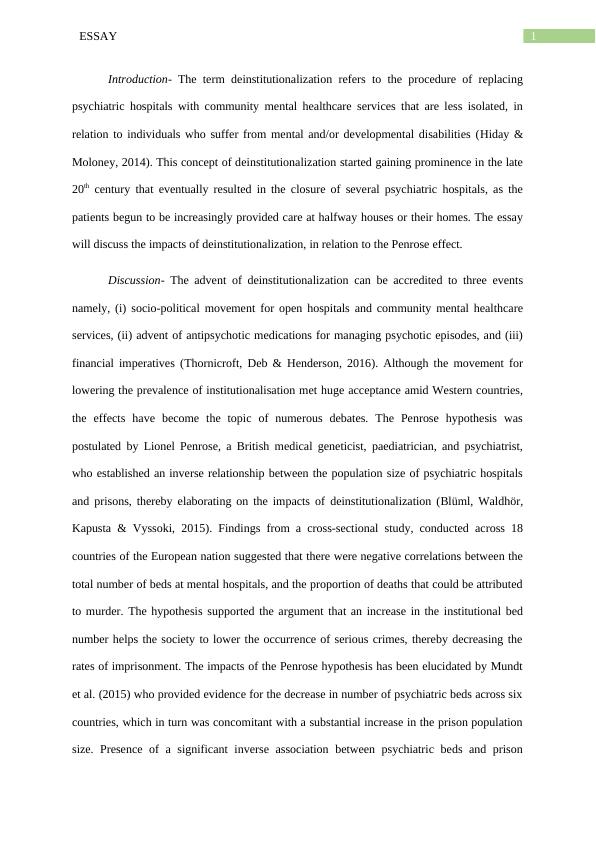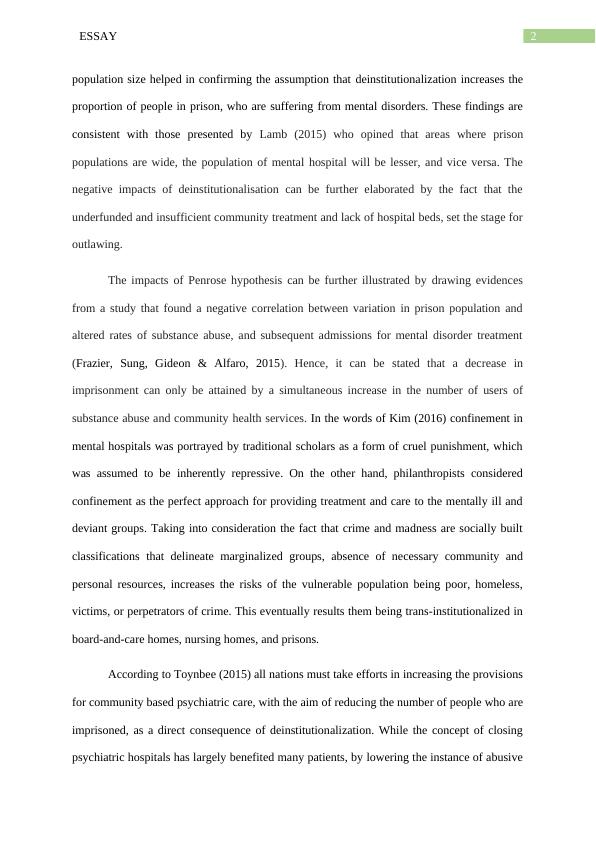Impacts of Deinstitutionalization: The Penrose Effect
Added on 2023-04-08
6 Pages1127 Words400 Views
Running head: ESSAY
Assessment 3 - Written Assignment
Name of the Student
Name of the University
Author Note
Assessment 3 - Written Assignment
Name of the Student
Name of the University
Author Note

1ESSAY
Introduction- The term deinstitutionalization refers to the procedure of replacing
psychiatric hospitals with community mental healthcare services that are less isolated, in
relation to individuals who suffer from mental and/or developmental disabilities (Hiday &
Moloney, 2014). This concept of deinstitutionalization started gaining prominence in the late
20th century that eventually resulted in the closure of several psychiatric hospitals, as the
patients begun to be increasingly provided care at halfway houses or their homes. The essay
will discuss the impacts of deinstitutionalization, in relation to the Penrose effect.
Discussion- The advent of deinstitutionalization can be accredited to three events
namely, (i) socio-political movement for open hospitals and community mental healthcare
services, (ii) advent of antipsychotic medications for managing psychotic episodes, and (iii)
financial imperatives (Thornicroft, Deb & Henderson, 2016). Although the movement for
lowering the prevalence of institutionalisation met huge acceptance amid Western countries,
the effects have become the topic of numerous debates. The Penrose hypothesis was
postulated by Lionel Penrose, a British medical geneticist, paediatrician, and psychiatrist,
who established an inverse relationship between the population size of psychiatric hospitals
and prisons, thereby elaborating on the impacts of deinstitutionalization (Blüml, Waldhör,
Kapusta & Vyssoki, 2015). Findings from a cross-sectional study, conducted across 18
countries of the European nation suggested that there were negative correlations between the
total number of beds at mental hospitals, and the proportion of deaths that could be attributed
to murder. The hypothesis supported the argument that an increase in the institutional bed
number helps the society to lower the occurrence of serious crimes, thereby decreasing the
rates of imprisonment. The impacts of the Penrose hypothesis has been elucidated by Mundt
et al. (2015) who provided evidence for the decrease in number of psychiatric beds across six
countries, which in turn was concomitant with a substantial increase in the prison population
size. Presence of a significant inverse association between psychiatric beds and prison
Introduction- The term deinstitutionalization refers to the procedure of replacing
psychiatric hospitals with community mental healthcare services that are less isolated, in
relation to individuals who suffer from mental and/or developmental disabilities (Hiday &
Moloney, 2014). This concept of deinstitutionalization started gaining prominence in the late
20th century that eventually resulted in the closure of several psychiatric hospitals, as the
patients begun to be increasingly provided care at halfway houses or their homes. The essay
will discuss the impacts of deinstitutionalization, in relation to the Penrose effect.
Discussion- The advent of deinstitutionalization can be accredited to three events
namely, (i) socio-political movement for open hospitals and community mental healthcare
services, (ii) advent of antipsychotic medications for managing psychotic episodes, and (iii)
financial imperatives (Thornicroft, Deb & Henderson, 2016). Although the movement for
lowering the prevalence of institutionalisation met huge acceptance amid Western countries,
the effects have become the topic of numerous debates. The Penrose hypothesis was
postulated by Lionel Penrose, a British medical geneticist, paediatrician, and psychiatrist,
who established an inverse relationship between the population size of psychiatric hospitals
and prisons, thereby elaborating on the impacts of deinstitutionalization (Blüml, Waldhör,
Kapusta & Vyssoki, 2015). Findings from a cross-sectional study, conducted across 18
countries of the European nation suggested that there were negative correlations between the
total number of beds at mental hospitals, and the proportion of deaths that could be attributed
to murder. The hypothesis supported the argument that an increase in the institutional bed
number helps the society to lower the occurrence of serious crimes, thereby decreasing the
rates of imprisonment. The impacts of the Penrose hypothesis has been elucidated by Mundt
et al. (2015) who provided evidence for the decrease in number of psychiatric beds across six
countries, which in turn was concomitant with a substantial increase in the prison population
size. Presence of a significant inverse association between psychiatric beds and prison

2ESSAY
population size helped in confirming the assumption that deinstitutionalization increases the
proportion of people in prison, who are suffering from mental disorders. These findings are
consistent with those presented by Lamb (2015) who opined that areas where prison
populations are wide, the population of mental hospital will be lesser, and vice versa. The
negative impacts of deinstitutionalisation can be further elaborated by the fact that the
underfunded and insufficient community treatment and lack of hospital beds, set the stage for
outlawing.
The impacts of Penrose hypothesis can be further illustrated by drawing evidences
from a study that found a negative correlation between variation in prison population and
altered rates of substance abuse, and subsequent admissions for mental disorder treatment
(Frazier, Sung, Gideon & Alfaro, 2015). Hence, it can be stated that a decrease in
imprisonment can only be attained by a simultaneous increase in the number of users of
substance abuse and community health services. In the words of Kim (2016) confinement in
mental hospitals was portrayed by traditional scholars as a form of cruel punishment, which
was assumed to be inherently repressive. On the other hand, philanthropists considered
confinement as the perfect approach for providing treatment and care to the mentally ill and
deviant groups. Taking into consideration the fact that crime and madness are socially built
classifications that delineate marginalized groups, absence of necessary community and
personal resources, increases the risks of the vulnerable population being poor, homeless,
victims, or perpetrators of crime. This eventually results them being trans-institutionalized in
board-and-care homes, nursing homes, and prisons.
According to Toynbee (2015) all nations must take efforts in increasing the provisions
for community based psychiatric care, with the aim of reducing the number of people who are
imprisoned, as a direct consequence of deinstitutionalization. While the concept of closing
psychiatric hospitals has largely benefited many patients, by lowering the instance of abusive
population size helped in confirming the assumption that deinstitutionalization increases the
proportion of people in prison, who are suffering from mental disorders. These findings are
consistent with those presented by Lamb (2015) who opined that areas where prison
populations are wide, the population of mental hospital will be lesser, and vice versa. The
negative impacts of deinstitutionalisation can be further elaborated by the fact that the
underfunded and insufficient community treatment and lack of hospital beds, set the stage for
outlawing.
The impacts of Penrose hypothesis can be further illustrated by drawing evidences
from a study that found a negative correlation between variation in prison population and
altered rates of substance abuse, and subsequent admissions for mental disorder treatment
(Frazier, Sung, Gideon & Alfaro, 2015). Hence, it can be stated that a decrease in
imprisonment can only be attained by a simultaneous increase in the number of users of
substance abuse and community health services. In the words of Kim (2016) confinement in
mental hospitals was portrayed by traditional scholars as a form of cruel punishment, which
was assumed to be inherently repressive. On the other hand, philanthropists considered
confinement as the perfect approach for providing treatment and care to the mentally ill and
deviant groups. Taking into consideration the fact that crime and madness are socially built
classifications that delineate marginalized groups, absence of necessary community and
personal resources, increases the risks of the vulnerable population being poor, homeless,
victims, or perpetrators of crime. This eventually results them being trans-institutionalized in
board-and-care homes, nursing homes, and prisons.
According to Toynbee (2015) all nations must take efforts in increasing the provisions
for community based psychiatric care, with the aim of reducing the number of people who are
imprisoned, as a direct consequence of deinstitutionalization. While the concept of closing
psychiatric hospitals has largely benefited many patients, by lowering the instance of abusive

End of preview
Want to access all the pages? Upload your documents or become a member.
Related Documents
Penrose Effect: The Relationship Between Mental Health and Crimelg...
|4
|910
|126
